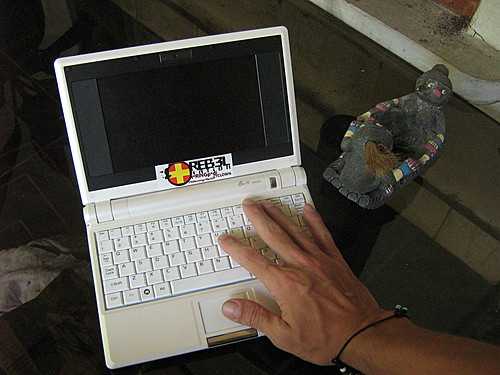

leave your comments
 printable page
printable page
Since 2008 the EEEPC is my travelling deck, starting with my first journey in Indonesia. It is also the very first brand new laptop I ever bought: this new 7" Asus model is amazingly cheap, sold in Singapore in for 600 SGD (~300EUR in Dec2007), while the entry cost in Indonesia was 4 millions IDR in Feb2008.

The best feature consists in being completely solid state: no mechanical parts moving, which means more robust and less energy consuming. It is equipped with a Pentium M with 512 of RAM and 4GB NAND (internal storage), has wifi modem and ether-net, an SD card slot, usb2.0, sound-card and even a web-cam.
I place my bet this machine is going to break through the market in the coming year.
As soon as it was out, geeks worldwide have been sporting several hardware hacks on the EEEPC.
It comes off the shelf equipped with GNU/Linux: a user friendly installation of Xandros (Debian based) configured for a newbie or anyone used to work on M$ wind-blows.
I didn't really kept the original system intact, instead worked on tweaks since the very first day: I'll share my hacks here and in the file repository on ftp://ftp.dyne.org/eeepc (for EEEPC models 701 and 900 ONLY).
There is one big problem in all this: unionfs is bugged, at least it was the one shipped with my EEEPC. It is bugged so badly that, if you delete any file in your home NAND it will not free the space.
It is a major nasty issue that everyone will face when starting hacking on the EEEPC: the unionFS factory setup. For the Xandros recovery system they thought it was necessary to partitin the 4GB in 2 parts and let the first hold the system, while the second the modifications done to it: this way by deleting the second partition one can go back to the initial installation.
Fresh EEEPC users will experience quite some frustrations as they'll see their home space filled up, installing a proper system on these machines is necessary for reliable use.
We don't need unionFS and will do recovery by hand from a bootable USB stick eventually. I hope Asus will change idea in future and follow this way, meanwhile to get rid of all this madness you need to deactivate UnionFS.
You need to change this situation also if you want to install a new kernel or you want to change any boot configuration file in /etc, as the boot will read the rc. files without unionfs, all your "userspace" modifications won't be active.
Disclaimer: hacking on the GNU/Linux kernel is not so simple, in case you are new to it keep close to your guru for any help needed
As soon as i booted it I felt the need to compile my own kernel for this machine - that's what makes you feel 0wn1ng a deck, right? so, here we go: ftp://ftp.dyne.org/eeepc/kernel (EEEPC 701 and 900 ONLY). This Linux kernel is the same version as the factory default (2.6.21.4), but re-compiled with more features than the default in EEEPC, while keeping complete compatibility (fully tested).
Main features included:
happy hacking :^)

|


|




|
 copyleft 2000 - 2009 dyne.org
foundation and respective authors. Verbatim copying
and distribution is permitted in any medium, provided
this notice is preserved.
Send inquiries & questions to dyne.org's hackers. copyleft 2000 - 2009 dyne.org
foundation and respective authors. Verbatim copying
and distribution is permitted in any medium, provided
this notice is preserved.
Send inquiries & questions to dyne.org's hackers.
|

|